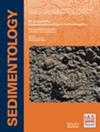风沙的超长距离运输:中国东南部山间沙漠的物源
IF 2.8
2区 地球科学
Q1 GEOLOGY
引用次数: 0
摘要
本文章由计算机程序翻译,如有差异,请以英文原文为准。
Ultra‐long‐distance transport of aeolian sand: The provenance of an intermontane desert, south‐east China
Intermontane deserts are an important type of arid‐climate sedimentary system. Although rare at present, the sedimentary records of intermontane deserts reveal their widespread development in past greenhouse periods, and they might develop in the near future in response to ongoing global warming. Determination of the provenance of sand supplied for the construction of intermontane deserts is important to gain improved understanding of the potential impact of future climate on environmental evolution in arid and semi‐arid regions. During the Cretaceous, a typical intermontane desert developed in the Xinjiang Basin, south‐east China. In this study, the origin, spatial variability, and transport pathways of both aeolian and alluvial–fluvial sediments in the Xinjiang intermontane desert are investigated by analyses of bulk‐rock petrography and detrital‐zircon U–Pb geochronology. These results demonstrate that the sand in the Xinjiang intermontane desert succession was mainly of extraneous origin and wind‐derived. The nearby South China Block and South China Magmatic Belt were primary sources, and the 1000 km distant western margin of Yangtze Block was an important secondary source. During the Late Cretaceous, the westerlies were stronger in the northern than in the southern hemisphere with doubled wind speeds. In such a climatic context, the results herein suggest that the ultra‐long‐distance aeolian sediment transport was likely further enabled by two factors: (i) the strengthening of intermittent westerly winds during short‐lived glacial episodes; and (ii) the presence of a low‐relief corridor that served as a transport pathway from source to sink.
求助全文
通过发布文献求助,成功后即可免费获取论文全文。
去求助
来源期刊

Sedimentology
地学-地质学
CiteScore
8.20
自引率
11.40%
发文量
94
审稿时长
6-12 weeks
期刊介绍:
The international leader in its field, Sedimentology publishes ground-breaking research from across the spectrum of sedimentology, sedimentary geology and sedimentary geochemistry.
Areas covered include: experimental and theoretical grain transport; sediment fluxes; modern and ancient sedimentary environments; sequence stratigraphy sediment-organism interaction; palaeosoils; diagenesis; stable isotope geochemistry; environmental sedimentology
 求助内容:
求助内容: 应助结果提醒方式:
应助结果提醒方式:


